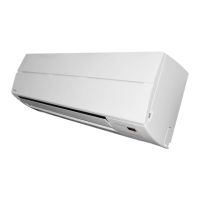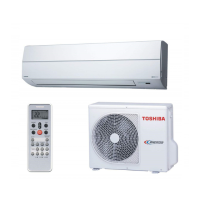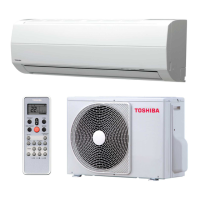
Do you have a question about the Toshiba RAS-18SKP-ES and is the answer not in the manual?
| Brand | Toshiba |
|---|---|
| Model | RAS-18SKP-ES |
| Category | Air Conditioner |
| Language | English |
Comprehensive technical data and parameters for various air conditioner models.
Detailed diagrams showing the assembly and dimensions of the indoor unit.
Detailed diagrams showing the assembly and dimensions of the outdoor unit.
Electrical schematic illustrating connections for specific RAS SKP/SA models.
Electrical schematic illustrating connections for specific RAS SKHP/S2AH models.
List and specifications of electrical components for RAS-18/24SKP-ES indoor units.
List and specifications of electrical components for RAS-18SA-ES outdoor unit.
List and specifications of electrical components for RAS-24SA-ES outdoor unit.
List and specifications of electrical components for RAS-18/24SKHP-ES indoor units.
List and specifications of electrical components for RAS-18S2AH-ES outdoor unit.
List and specifications of electrical components for RAS-24S2AH-ES outdoor unit.
Diagram illustrating the refrigerant flow and components for specific models.
Diagram illustrating the refrigerant flow and components for specific models.
Diagram illustrating the refrigerant flow and components for specific models.
Diagram illustrating the refrigerant flow and components for specific models.
Block diagram of the control system for SKP/SA series air conditioners.
Block diagram of the control system for SKHP/S2AH series air conditioners.
Explanation of the remote control buttons and their functions for operating the unit.
Guide to understanding the symbols and information shown on the remote control display.
Overview of the control logic between indoor and outdoor units.
Details on how vertical louvers and indoor fan speed are managed.
Explanation of Fan Only and Cooling modes, including fan speed settings.
Explanation of Dry and Heating modes, including compressor and fan control.
Logic for automatic mode selection and safety controls like temperature limits.
Information on the defrost cycle and low-temperature protection mechanisms.
How to use and the effects of special operating modes like Hi POWER, QUIET, ECO, and COMFORT SLEEP.
Procedures for resetting the filter indicator and setting up auto restart.
Explanation of the self-cleaning function, its purpose, and operation times.
Essential safety warnings and guidelines for installing the air conditioner unit.
Diagram showing recommended clearances and placement for units.
List and specifications of optional parts for unit installation.
List of included accessories and parts necessary for installation.
Required tools for installing systems using R410A refrigerant.
Guidelines for selecting an appropriate location and mounting the indoor unit.
Steps for drilling holes and mounting the indoor unit's installation plate.
Instructions for connecting electrical wires to the indoor unit.
Procedures for installing refrigerant pipes and drain hoses for the indoor unit.
Final steps for securing the indoor unit and ensuring proper water drainage.
Guidelines for selecting outdoor unit location and connecting refrigerant pipes.
Steps for system evacuation and important precautions for piping work.
Instructions for connecting electrical wiring to the outdoor unit.
Procedures for verifying correct operation after installation.
General approach to troubleshooting and initial system checks.
Identifying issues based on unit indicators and simple checks.
Using the remote control to retrieve and interpret diagnostic error codes.
Flowchart for diagnosing serial signal errors and four-way valve issues.
Flowchart for diagnosing other cycle errors related to compressor and fan.
Flowchart for diagnosing sensor errors and discharge temperature issues.
Step-by-step guides for resolving common indoor unit operational problems.
Diagnosing issues related to interconnect cables and outdoor unit operation.
Procedures for checking and troubleshooting the main control boards.
Steps to diagnose and fix problems with the wireless remote control.
Detailed instructions for disassembling and replacing major components of the indoor unit.
Exploded view and list of electronic parts for the indoor unit assembly.
Detailed exploded diagrams and part numbers for indoor unit components.
Exploded view and parts list for specific outdoor unit models.
Exploded view and parts list for other specific outdoor unit models.










